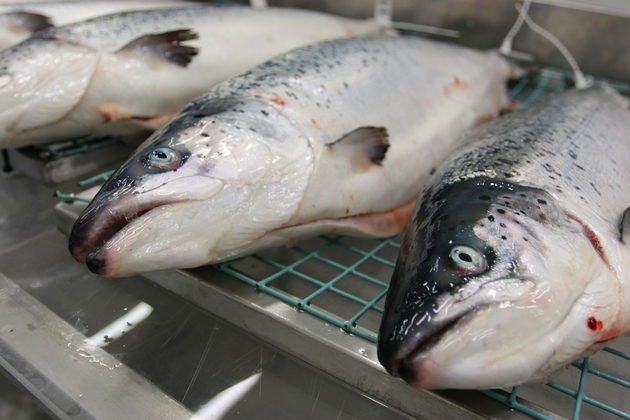
In the world of aquatic life, the importance of the intestinal microbiota for the physiological processes of mammals is a well-established fact. However, the functional roles of these microorganisms in fish remain largely uncharted waters.
A recent study published by scientists from the Chinese Academy of Agricultural Sciences, the Norwegian University of Life Sciences, Cermaq Group AS, and Cargill Aqua Nutrition aims to bridge this knowledge gap by delving into the relationship between the taxonomic composition of the intestinal microbiota and the intestinal health of Atlantic salmon.
Furthermore, they explore the potential influence of dietary prebiotics in a real-world scenario: a salmon farming cage in open waters. The findings of this research shed light on the intricate interactions within the fish’s intestinal microbiota, providing insights into the factors affecting intestinal health in these aquatic creatures.
The Study Setup
Researchers used Atlantic salmon with an initial average body weight of about 240 grams. These salmon underwent different dietary regimes during the marine production phase from December to September the following year.
One group received a diet without prebiotics (the Ref diet), while the other group received a diet enriched with prebiotics based on yeast cell wall (the test diet). Sampling was conducted at three specific time points: January, April, and September, corresponding to different water temperatures of 3.9 ℃, 3.4 ℃, and 9.6 ℃, respectively.
Growth and Intestinal Health
During the course of the study, scientists recorded several key indicators of intestinal health and overall well-being, which showed positive trends. Particularly, growth, membrane enzymatic activities, and the expression of numerous genes associated with immune, barrier, and metabolic functions significantly increased.
This positive trajectory was also reflected in a noticeable reduction in the accumulation of lipids in pyloric enterocytes, indicating a remarkable improvement in intestinal health.
Surprisingly, despite the difference in dietary treatments, fish growth remained consistent. This suggests that the addition of dietary prebiotics had a marginal impact on the overall growth of Atlantic salmon.
Intestinal Microbiota Dynamics
The composition of the Atlantic salmon’s intestinal microbiota was not static. The study revealed a decrease in alpha diversity (including measures such as observed species, Pielou, and Shannon) over time. This decrease was significantly related to the increased relative abundance of the Mycoplasma genus, accompanied by a decrease in 32 different taxonomic groups at the genus level, including lactic acid bacteria (LAB) such as Lactobacillus, Leuconostoc, and Lactococcus.
This observation suggests that the developmental stage of Atlantic salmon plays a crucial role in shaping the microbial composition within their intestines.
The Role of Mycoplasma and LAB
The research unveiled intriguing associations between specific microbial groups and various physiological parameters.
In particular, the relative abundance of Mycoplasma positively correlated with time and the expression of intestinal barrier genes while showing a negative correlation with plasma glucose levels. Interestingly, dietary prebiotic exposure slightly increased the relative abundance of Mycoplasma.
On the other hand, certain LAB, including Leuconostoc, showed a negative trend over time and displayed significant associations with plasma nutrient levels (e.g., triglycerides and cholesterol) and gene expression related to intestinal barrier and immune function.
Conclusion
This study represents a significant step in understanding the intricate relationship between the intestinal microbiota and the health of Atlantic salmon. As these salmon grow in a large-scale commercial farm, the Mycoplasma genus becomes increasingly prominent, while LAB decreases. Dietary inclusion of prebiotics had only a marginal impact on the intestinal health of these fish.
The findings underscore the complexity of microbial communities within fish intestines and highlight the role of developmental stages in shaping the microbiota.
This knowledge is invaluable not only to the aquaculture industry but also for a deeper understanding of the intricate symbiosis that occurs within the gastrointestinal tract of aquatic species. As research continues, we can expect to gain more insights into how to optimize intestinal health for the benefit of fish populations and aquaculture practices.
The study was funded by the Norwegian Research Council and China Scholarship Council.
Contact
Jie Wang
National Aquafeed Safety Assessment Center, Institute of Feed Research
Chinese Academy of Agricultural Sciences
No.12 Zhongguancun South St, Beijing, China
Email: wangjie03@caas.cn
Reference (open access)
Wang, J., Li, Y., Jaramillo-Torres, A. et al. Exploring gut microbiota in adult Atlantic salmon (Salmo salar L.): Associations with gut health and dietary prebiotics. anim microbiome 5, 47 (2023). https://doi.org/10.1186/s42523-023-00269-1

